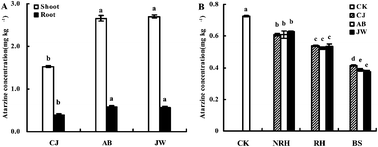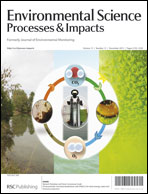Bioaccumulation and degradation of atrazine in several Chinese ryegrass genotypes†
Abstract
Soil pollution with herbicides is a global problem. Before phytoremediation technology is developed for the plant-based clean-up of polluted soils, investigation of potential plants that can be used to accumulate and degrade herbicides is a critical step. In this study, three selected genotypes of ryegrass were comprehensively analyzed with regard to the atrazine accumulation, degradation and toxicological response. Under the conditions of soil with 0.8 mg kg−1 atrazine, the maximum value for atrazine accumulation was 2.70 mg kg−1 in shoots and 0.58 mg kg−1 in roots. The residue of atrazine in soil with ryegrass cultivation was much lower than that in soil without ryegrass cultivation. Also, the content of atrazine residues in the rhizosphere was significantly lower than that in the non-rhizosphere soil. Activities of several enzymes (urease, invertase, polyphenol oxidase, acid phosphatase and alkaline phosphatase) in soil were assayed. These enzymes were depressed by atrazine but activated by ryegrass cultivation, even in the presence of atrazine. Finally, comparative studies have been conducted on the ryegrass genotypes in response to atrazine. They showed different capacities of degradation and bioaccumulation of atrazine. One of the grass cultivars Changjiang II (CJ) had better growth and higher levels of chlorophyll, but displayed less oxidative injury than two others, Abode (AB) and Jiewei (JW), under atrazine exposure.


 Please wait while we load your content...
Please wait while we load your content...